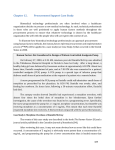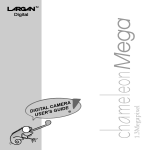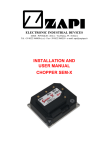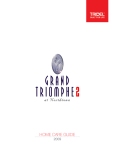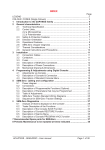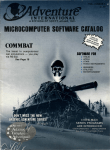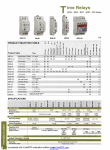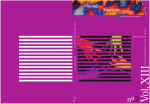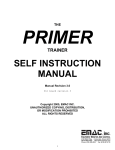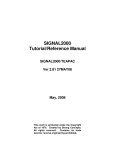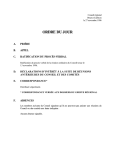Download national radio astronomy observatory green bank, west virginia
Transcript
NATIONAL RADIO ASTRONOMY OBSERVATORY GREEN BANK, WEST VIRGINIA ELECTRONICS DIVISION INTERNAL REPORT NO. 264 ANALYSIS OF AN ARRAY FEED DESIGN FOR THE 300 FT TELESCOPE PETER D. LAWSON (1986 SUMMER STUDENT) NOVEMBER 1986 NUMBER OF COPIES: 150 ANALYSIS OF AN ARRAY FEED DESIGN FOR THE 300-FT TELESCOPE Peter R. Lawson TABLE OF CONTENTS Page 0 0 0. 9. Results ................ 00000.000...0.0000000000000.00 10. Discussion 0.000...0.000000 000000.0.000.00000.00000000 11. References 12 14 15 000.000.0..00.00 000000000000.00.0000000000.25 LIST OF FIGURES 3 Calculated Far Field Field Patters Patters for for the the 300-ft n gle Feed ............ Telescope Scanned with a Si The Element Feed Pattern The Trial Run of Program Program necdata.f necdata.f to Produce the to Produce the Field Pattern of a a Phased Phased Array Array Phased by a Butler Matrix .0000000000000.0..00.0000.0.00.0.00 Calculated Far Field Patterns for the 300-ft Telescope Scanned with with an an Array Array Feed Telescope Scanned ............ Feed ............ 17 1 8 19 20 APPENDICIES Running the the NEC NEC Program Program and Results ....... andDisplaying Displaying Results ....... 21 Warning concerning the NEC Use of Aperture Integration and the Geometrical Theory 00f f Diffraction Diffraction 0.00000.000.000...00.0000.00.00000 214 ANALYSIS OF AN ARRAY FEED DESIGN FOR THE 300-FT TELESCOPE Peter R. Lawson Introduction The 300 ,-ft telescope is a transit instrument; therefore, its motion is restricted to a rotation in the north- , south direction. In order for a particular observation to be made the telescope must wait for the object of interest to approach the meridian and then attempt to track the object as it enters and leaves the telescope's field of view. Up until now the tracking has been accomplished by moving a single feed from the focal point. This offset steers the far field beam in the opposite direction. As the offset is increased, the gain of the far field pattern is reduced and the levels of the nearest s i del obes are significantly increased. Such a development may be seen in Figure 1. As a result, the telescope can only steer the beam over a limited region. If it were possible to correct the beam at wider scan angles and consequently to increase the tracking time, then observations of weak sources would be substantially improved. It has been suggested that an array feed, mounted in the focal plane of the 300-ft, would improve the telescope's performance. It is the purpose of this report to examine and discuss an array feed design intended for use with the 300-ft telescope. I would like to outline the present problem, discuss the theory behind the operation of the feed, give an intuitive understanding of how it functions, and detail the steps necessary for its analysis. Extensive use has been made of the Numerical Electromagnetic Code (11). The code, now installed on the Convex computer at NRAO Charlottesville, was used to produce far field patterns of the hybrid antenna. A separate program was used to describe the radiation pattern of the array feed. The software which describes the feed pattern, and produces data for the analysis, will be described. Included as well are several notes on file transfers between the Convex and the MassComp computers. Although the analysis was carried out on the Convex in Charlottesville, VA, the display of data was done on the MassComp in Green Bank, WV. Such notes are useful if further analysis is to be done of this design. The following work was carried out during the summer months of 1986 under the direction of Jim Coe at the National Radio Astronomy Observatory in Green Bank, West Virginia. 2 Focal Plane Arrays for Hybrid Antennas Consider a point source an infinite distance away at an angle O b, measured with respect to the axis of rotation of the parabola. From this source a plane wave is received at a parabolic reflector antenna. The wave passes through the aperture and is reflected and imaged in the focal plane. A focal plane array attempts to reproduce, in transmission, the complex conjugate of the fields that were set up by the source. If this is possible, then an ideal beam shape would be obtained in the 0 13 direction. The success of the array in producing the desired beam is dependent upon the complexity of the field produced by the imaginary source and how well it is sampled by the placement of array elements. It may be noted that for plane waves arriving along the axis of rotation of the reflector the shape of the fields in the focal plane is given by an Airy function containing a sharp peak. This field is sampled well using a single feed that produces a spherical phase front. However, when large scan angles O b are considered, the focal plane fields become more complicated and are inadequately sampled by a single feed. A loss in gain and an increase in sidelobe levels is the result. If low sidelobe levels and higher gain is desired, it is necessary to increase the sampling of the fields, and therefore to set up an array feed. An antenna with the combination of array feed and reflector is called a hybrid antenna. Most authors who build hybrid antennas use a large number of elements and build planar arrays. This is seen frequently in satellite feed design for broadcasting. In such cases there exist "optimal filtering" algorithms [17] which will phase and amplitude weight the elements if the focal plane field is known for a given offset angle. This approach, however, is impractical when only a small number of feeds are considered and the beam structure does not resemble a banana republic. The design being considered will use a linear array of only eight elements to sample the aperture fields. It has been assumed that since the off-axis scan is in only one direction, that a linear array in that direction would provide adequate sampling. A Butler matrix is to be used to phase the array. This takes advantage of the relationship discussed in a paper by Rudge and Withers [13] and greatly simplifies the control of the array. 3 Why use a Butler Matrix? If the focal plane fields can be determined for an off-axis source, then, in order to correct for aberrations, a focal plane array must attempt to recreate the complex conjugate of those fields. A Butler Matrix will simplify this procedure under the proper circumstances. There exists a Fourier transform relationship between the aperture fields and the focal plane fields [13, 14]. The relationship is valid for aperture fields from off-axis sources if the transform planes are suitably defined [13]. The Butler Matrix operates as a microwave analog of a fastFourier transform device [1, 6, 9]. If the focal plane fields are sampled by an array of elements controlled by a Butler Matrix, then the output from the matrix will resemble the fast-Fourier transform of those fields. The output from the Butler matrix therefore represents the twice Fourier transformed aperture field distribution. A field distribution that is twice Fourier transformed will remain unchanged except for a scaling factor. If the aperture fields had a uniform amplitude distribution, then the fields, as transformed by the matrix, will also have a uniform amplitude distribution. If a Butler Matrix is used, then we do not need to amplitude weight the signals in order to achieve conjugate field matching in the focal plane. All the control that is required is input These phasings will then port phasings to the Butler Matrix. correct for offset feed displacement. The Butler Matrix A very good description of the Butler matrix can be found in the paper by Browning, Adatia and Rudge [14]. The Butler matrix is a passive and theoretically lossless orthogonal beam forming matrix which possesses e l input and output ports and is capable of producting a set of 2 n simultaneous orthogonal beams in space, when coupled to a uniform array of feed elements. In the transmit mode, a signal applied at an input port produces a uniform amplitude distribution across the output ports but with an interelement phase difference which is dependent upon the particular input port. This results in a far-field beam, which is composed of the elemental radiation pattern weighted by the array factor; the inclination of the main beam to the array normal is dependent upon the interelement phase difference. If signals are applied at all input ports, a set of simultaneous orthogonal beams are generated; since they are orthogonal, the amplitudes and phases of the individual beams may be controlled independently. 4 The Butler matrix phases a linear array and thus all the orthogonal beams are linear array patterns. The angular locations of the orthogonal beam peaks are important in determining the proper phase to apply to the input The beams produced by the Butler ports of the Butler matrix. matrix are said to be orthogonal. They are separated spatially so that their main lobes do not overlap above the half power points. If a linear array, fed by a Butler matrix, is used as a feed, then the beams will each be imaged onto separate, but adjacent, regions of the reflector aperture. The angular position of the beams O n may be used to determine the center of the regions where the bead's are imaged. The phase distribution in those regions may be adjusted by controlling the phasing of the beams. In this way aperture phase aberrations, due to lateral feed displacement, may be reduced. A. Linear Arrays: The field pattern of an array of non-isotropic antenna elements is the product of an "Array factor" and an "Element factor". The array factor is dependent upon the geometry of the array. The element factor represents the far field pattern of a single element in that array. The Array factor: The Array factor of a linear array of N equally spaced elements is [1]: ja a El e o 1+e +e j2lp ••. + e (1) where a o is an arbitrary phase reference, E l is the magnitude of the field at each element (assumed equal) and * is a geometrical pathlength dependent upon the element separation d and the element phasings 6n. (2) sine sin ci) - 6 Equation (1) can be rewritten in the following manner: E E e a sin (NO2) j(N-1)02 sin (02) e (3) Since ao is an arbitrary phase reference it may be set to -(N-1)11)/2. The resulting array factor is Eacc sin (1■14/2) sin (02) (4) 5 For antenna gain calculations the magnitude of the field is of no consequence (if more power is radiated, the gain will not change), and therefore the E l term has been dropped. The Element factor: An analytical function has been chosen to represent the Element factor. It is given as follows: E (1 0 cos n/2 (5) + e where A and n are parameters which shape the function. This was chosen to approximate the pattern of a cavity-backed crossed dipole (A = 0.78, n = 5.0). A comparison between this function and an averaged E and H plane field patterns of the actual element is shown in Figure 2. The actual element is a cavity-backed crossed dipole designed for use at 400 MHz. B. Linear Arrays Fed By a Butler Matrix: As the amplitudes and phases of each beam may be controlled independently, we have as a total pattern NI2 jan a A(0,0 = n e sin (NW2) sin (P/2) -• N= -N/2 where a n and a n are, respectively, the applied amplitude and phase weights. The peaks of the individual beams appear at si_n 2 1 n 1- n = , t2 tN/2 Building the Array Feed Rudge suggests that a good choice of element spacing is [21] where a = sin 6 and e is the angle subtended by the by the reflector rim (observed from the focus and measured from the axis). This choice of spacing "... excludes the formation of grating lobes over the angular spectrum subtended by the reflector from the focus." Rudge lists other benefits as well. 6 The 300-ft antenna has a focal length of 1525 inches [22] and a diameter, one would guess, of 300.00 ft. The depth of the reflector is thus (with z = r 2 /4f) 44.26 feet. We now can find 0 = 61.1° and 2sin0 = 1.75. So without any loss of accuracy we may write that = 4A 7 The phased array feed is to be designed for operation in the region of 400-500 MHz. This would give us (at 450 MHz) a wavelength of approximately 66.67 ems. The array element spacings for this would then be 38.10 ems. An eight element linear array was chosen. If a Butler matrix is to be used the number of elements must be a power of 2. Butler matrices with 16 elements (the next possible) are much more difficult to build, incur more signal loss and would present a significantly larger aperture blockage. The total array of 8 elements would be 7 spacings long or 2.66 meters (4A) from the centers of the furthest elements. Using eight elements the beam directions, as produced by the Butler matrix, are shown in the following table. Beam #n -4 -3 -2 -1 1 2 3 Angle -49.96° -33.19° -19.16° -6.28° 6.28° 19.16° 33.190 49.96° Beam Directions iiik19114(•P We have now described the array and the fields it produces. In order for it to work as part of a hybrid antenna we must determine the phasings at the input ports to correct for lateral feed displacement. Phasing the Element Beams Since we have decided not to amplitude weight the inputs, we have only the eight input port phasings to contend with. If the reflector lies in the far field of the array, then we may make some simplifications [12]. The far field begins - D 2 /X away from the array. D is the largest dimension of the array (- 4A) and A is the wavelength in use 66 ems). The far field thus begins about 10 meters from the feed (or about 30 feet). Since the focal length (127 ft) of the reflector is more than four times that distance it is safe to say that the reflector is in the far field. The array thus has, as viewed from the reflector, a well defined phase center. It may be moved as if it were a single feed and the element beams appear to originate from the center of the array. If an analytic expression is to be used for the phasings (i.e., an expression for coma), or if the correction is to be done by pathlength error from feed to aperture, we need to know where in the focal plane the feed lies and where, in the aperture, the element beams are imaged. If the wavelength is much smaller than the curvature of surface of the reflector then geometrical optics is applicable and we can use raytracing to map the beams. Raytracing is hinted at in [14] and it is used here as the simplest manner of determining the phasings. If we are given the origin of the ray the unit vector describing the ray' s direction, then a computer program can be used to reflect the ray from the main reflector, map it onto the aperture, and determine the pathlength of the ray. TRACE is such a raytracing program. TRACE is a simplified version of RAYTRACE. RAYTRACE was written at the VLA by Peter Napier, and was intended to study shaped subreflectors of Cassegrain antennas for the VLBA project. I have removed RAYTRACE's amplitude calculation, added my own intersection routine (using FMIN [23] for a Golden Search method) and removed the problem of ray's propagating in the y = 0 plane. I have, of course, removed the subreflector entirely, and calculations are performed for only a single ray. TRACE is a subroutine. The phasings of the input ports is the most crucial aspect In the design of this system. The following is a description of how the phasings are determined. 1. Position the array at an offset distance. 2. Map the element beams onto the aperture through raytracing. The location of the array center defines the origin of the ray to be traced. The origin of the ray is located with respect to the vertex of the main reflector and is given by (X 0 , Yo, Z 0 ) where X o 0, Y o = Ay and Z = f Ay is the offset distance from the focal point and f is the focal length of the parabolic main reflector. 8 The direction of the ray is given by the beam angle G. In the convention used by the raytracing program that vector would be (0, sin Op, cos Op). This may be thought of as a vector originating at the intersection of the ray and main reflector, and pointing towards the feed center. A call to the subroutine trace yields the aperture coordinates x,y and the path error measured with respect to the optical path length f + (D/2)2/4f. Phase the beams to correct for aberrations. There are 3. three ways which have been tried to correct for phase errors: i) primary coma, ii) all coma terms, and iii) residual phase errors after a least square fit. i) Primary coma is described by Ruze [4] and is given by 3 21r A y r cos 4f3 where r and (/) are aperture coordinates, f is the focal length, Ay is the offset of the feed and A is the wavelength. ii) The above equation comes from a more general expression [4] written as follows: 271--- Ay cosq) sin6' A where 2 r/f sine' 1 + (r/202 2f - (1 4 + 2f primary coma arises out of the second term in the series. The first term is linear in r can causes beam shift but does not distort the beam [4]. If we wish to include all coma terms, but remove the linear term, then we should write r/f A 1. . -] Ay coscp 1 + (r/20 f 2 iii) These ex p resssions are all theoretical, and yet we know the phase errors from the path error calculated by our ray tracing program. 9 It has been mentioned that a linear phase progression, across the aperture, will not adversely affect the beam shape. Therefore, what we would like to do is correct for errors that occur over and above a linear shift. Since we have sampled the phase errors at the beam locations we can fit a line to those points. (The array beams lie along the y axis and a plane fit is therefore unnecessary.) This line is a least-squares approximation described in [20]. The phase errors with respect to this line are found at the beam locations and the beams are phased by the negative of these errors. Although not yet attempted, a better fit would be found if the points were weighted by the amplitude of the element pattern. 10 Evaluating the Performance of Hybrid Antennas A. Possible approaches using the NEC reflector program. The analysis is performed by attempting to produce the far field pattern of the hybrid antenna. This will give us information not only about the gain but also about the sidelobe levels and the beam shape. The far field pattern may be determined by the NEC reflector code [11, 12]. This program uses a combination of Aperture Integration and the Geometrical Theory of Diffraction to calculate beam patterns. It will accept any feed pattern with a well determined phase center, and is able to account for aperture blockage and strut scattering. It assumes that a parabolic reflector is used and that the feed is located near the focus. (See item iii in the discussion.) We could use this code in two different ways. If we are able to determine the complex excitations of 1. the array elements, then each element may be examined separately, in combinations with the reflector, to produce a far field beam. The total far field beam is then the sum of all far field beams produced by the element/reflector combinations. If the reflector is in the far field of the array, 2. then, as viewed from the reflector the array has a well defined phase center. The far field pattern of the array therefore may be used as a feed pattern. B. Which method to use? In order to use the first method the complex element phasings must be determined. This would involve working through the Butler matrix to determine the phasings contributed from each input port. The contributions from each port must then be summed Each element is then used separately with the at each element. The total field is NEC code to obtain a far field pattern. obtained only after all feeds have been treated. This method is lengthy and requires the the NEC code to be called numerous times for one total field calculation. The second method is described in a report concerning development work with the NEC program [12]. If the reflector is located in the far field region of the array feed, a straightforward two-step procedure can be used to calculate the reflector pattern with an array feed very efficiently. The first step is to input the information associated with the array feed, such as the element pattern and location, then the far field patterns of the array feed The second step are calculated and stored. uses these far field patterns as though it 11 was a single feed to calculate the radiation patterns of the reflector. This two step procedure calculates the reflector patterns very efficiently because the [algorithm] is applied only once for each aperture point. As it has been shown that the reflector is in the far field, the second method would appear to be the most efficient. It was therefore used in this work. 12 Describing the feed pattern for the Numerical Electromagnetic Code If we are to use the two step procedure then we must calculate The array pattern can be the far field pattern of the array. It is important to calculated once the phasings are known. understand the geometry of the input array pattern to be sure The geometry of the that the output from the code is correct. feed pattern is as follows: -E. The array lies along the y axis, the center of the coordinate system is located at the center of the array. Variables for the feed description: What follows is a brief description of the array feed pattern as it is presented to the NEC program. The program requires numerous input variables to be defined. indicated here. These variables are Although the array factor is rotationally symmetric about the y axis, the product of array and element factor is only symmetric, by reflection, about the y-z plane. A piecewise linear feed pattern is to be used, the feed is linearly polarized, the output is in dB and, as noted before, the symmetry is about the y-z plane (y-axis). The polarization angle of the pattern, relative to the x axis, is 45°: LLFD=.TRUE., LCP =.FALSE., LDB=.TRUE., ISYM=3, TAU=45.0. The feed pattern is sampled and in general the "feed" is not located at the focus: NHORN=0, LFOCUS=.FALSE. 13 The offset of the feed is along the y axis and in the focal plane: DXS(1)=0, DXS(2)=Ay, DXS(3)=0. The input pattern is0 described in planes of constant (1). For y-axis symmetry -906090 is all that is required. 15 (0 planes is all that the program allows and so 15 are used here: NPHI=15. In each plane of constant (0 the field is described at up to 77 6 locations (amplitude and phase) 05.65.180 for all symmetries. 77 points are used here with OSOS90°: N2=77. The output patterns of most interest lie in the (1) = 90° plane. (This lies along the y axis and here positive 6 corresponds to positive y values.) It is in this plane that the beam peak of the hybrid antenna will lie since the scan is along the y direction. 14 Results Software was developed to describe the array feed, and three different phasings were examined. The best results were obtained with phasings derived from residuals of a least-square fit to the phase errors. A trial run of the program is given in Figure 3. Far field patterns for this phasing method, used at various offsets, are shown in Figure 4. These patterns should be compared with the single feed patterns in Figure 1. We would like to describe the operation of the phased array feed as the offset of the feed is increased. The far"field pattern becomes unacceptable once the nearest sidelobes rise above a level of -15 dB measured with respect to the peak. This analysis does not take into account the effects of aperture blockage and strut reflection. They would complicate the analysis and have been therefore neglected. Using the phased array the 300-ft telescope produces a main beam identical to that produced using a single feed. The gain of the antenna is calculated to be 51.6 dB (with respect to an isotropic antenna). The near sidelobe structure is different but the highest sidelobes are more than 20 dB down from the main beam peak and the pattern as a whole is quite acceptable. There are no phase errors to correct for and thus all phasings are identical. At an offset of 6.2 feet the phased array shows a marked improvement in comparison with the single feed. Main beam shape remains identical to the focus single feed but the gain is now reduced to 49.0 dB (a loss in gain of 2.6 dB). The nearest sidelobe is about 17 dB down from the peak. At this offset the use of a single feed gives a broader beam and higher sidelobes. The sidelobes for a single feed are only 11.5 dB down from the peak. The beam is now scanned to 2.3 degrees. With a 10 ft offset the main beam shape is still retained but the gain is again decreased and the nearest sidelobe has risen. The gain is now reduced to 47.3 and the nearest sidelobe appears at 15.1 dB down. The beam is now scanned 3.65 degrees off axis. For further offsets the beamshape broadenes and the sidelobes rise very rapidly. This can be seen on the plot of Figure 4. For further offsets only, marginal improvements (if any) are evident when a comparison is made to the single feed. 15 Discussion For the method of phasing used, the beam of the 300-ft telescope is significantly improved up to feed offsets of about 1 0 ft. This corresponds to a total scan angle of 2 x 3.65° and a total tracking time of 29 minutes. If the sidelobe level was not crucial, the offset could be extended perhaps two or three feet and the tracking time could thus be extended by about 6 minutes. Using this method of phasing no appreciable increase in gain is seen. However, the beam shape of the focused single feed is preserved up to an off axis scan of about 3.7° and the sidelobes due to coma (and other aberrations) are suppressed to lower than 1 5 dB down from the main beam. Beyond a scan of 5° the beam shape has already severely deteriorated and this method of phasing only worsens the beam. I believe that better results may be obtained if an alternate method of phasing is adopted for larger scan angles. The success of this array design is wholly dependent upon the phasings chosen and it is quite possible that a better method of phasing may be developed for large scans. These results represent only one method of phasing. 16 Why does the array not work better? If the reflector is not truly in the far field of the array i) then the far field patterns, as derived here, do not accurately represent the hybrid antenna performance. The reflector is not clearly in the far field (by an order of magnitude) and this may affect the results. ii) The NEC program perhaps does not accurately represent the The program allows for an far field pattern for large scans. offset feed and yet suggests that the feed be near the focal If this is the case then we may have underestimated the point. antenna performance at large scan angles. iii) The focal plane field distribution, set up by a point source ( an infinite distance away) at a large scan angle, is perhaps insufficiently sampled by a linear array. It may be that a planar array is needed for proper compensation beyond a certain scan angle. The simplicity of the phasings with a Butler matrix may not large scans with a focal plane array. The method of phasing, and indeed the use of the Butler matrix, was chosen because of the Fourier transform relationship between iv) be sufficient for aperture and "focal plane" fields. This "focal plane" must be redefined for large scans. For large scans it no longer lies in the focal plane but is about one foot removed from it. This may affect the usefulness of the phasings. 17 FIGURE 1. Calculated Far Field Patterns for the 300-ft Scanned with a Single Feed. 60 60 50 50 40 40 30 30 20 20 10 10 ammounuillliik,, 0 -10 , -20 Ail' t Telescope ii, 1 ,L 1 , i, Iiiit r ., -30 -10 -5 10 15 -40 15 -10 -5 0 10 a) Feed displacement: 0.0 feet. b) Feed displacement: 6.2 feet. c) Feed displacement: 15.0 feet. d) Feed displacement: 23.0 feet. The feed pattern is that of the single feed given in Figure 2.b. i 18 FIGURE 2 The Element Feed Pattern. CAVITY BACKED CROSSED DIPOLE POWER PATTERN a) The cavity backed crossed dipole. -30 -100 -80 -60 -40 -20 0 20 Degrees 40 60 80 100 AVERAGED E AND H PLANE PATTERNS ELEMENT POWER PATTERN A raised cosine function approximation. -30 -100 -80 -60 -40 -20 0 20 Degrees 40 60 RAISED COSINE FUNCTION NOTE: The two patterns are very closely matched out to the edge of the reflector (at 61°). At wider angles the raised cosine approximation is more tapered. 80 100 19 FIGURE 3 A trial run of the program necdata.f to produce the field pattern of a phased array phased by a Butler Matrix. c**********************************************************************c NECdataMaker c**********************************************************************c This program is used to set up a feed pattern for the NEC reflector program. The feed pattern describes an eight element phased array which is phased to correct for aperture phase errors arising from lateral feed offsets. The output is a file DIN which is used by the NEC program to calculate the far field pattern of this Hybrid Antenna. This program has been set up for use with the 300 ft telescope at Green Bank. The focal length of the main reflector is 127.000 feet The Diameter of the reflector is 300.000 feet The wavelength used is 66.667 centimeters The corresponding frequency is 0.450 Ghz Do you wish to prepare data for 1) NEC program 2) PLOTP routines or 1 Input the offset from the focal point (feet) 6.2 Do you want to consider 1) A single Element feed 2) An Array feed ? or 2 Do you want to include the effect of non-isotropic array elements (y=1 ,n=0)? 3 Do you wish to correct for 1) All Abberations, or 2) Coma 3) Residuals of a Least Squares fit to the Phase errors in the Aperture How many points do you want along a cut <= 77 ? 77 Calling BeamAngles Calling BeamPhase Preparing data for cut # Preparing Preparing Preparing Preparing Preparing Preparing Preparing Preparing Preparing Preparing Preparing Preparing Preparing Preparing Offset = Beam 1 2 3 4 5 6 7 8 Note: data data data data data data data data data data data data data data for for for for for for for for for for for for for for cut cut cut cut cut cut cut cut cut cut cut cut cut cut # # # # # # # # # # # # # # 1 2 3 4 5 6 7 8 9 10 11 12 13 14 15 6.20 feet. Phase Errors Aperture Coordinates Patherr PathPhase LSQ-fit Prim-Coma All Coma y x Angle -183.48 -225.75 40.56 -4.79 -788.87 121.93 0.00 -49.96 -57.20 -62.82 -3.47 -570.36 -33.82 79.60 0.00 -33.15 -12.45 -12.87 -39.37 -2.13 -349.83 46.93 0.00 -19.16 -0.72 -0.72 -17.56 -0.78 -127.75 17.99 0.00 -6.28 0.12 0.12 12.75 95.57 0.58 -9.91 0.00 6.28 7.14 7.31 36.88 320.06 1.94 -38.86 0.00 19.16 42.52 45.91 35.54 545.95 3.32 -71.70 0.00 33.15 156.52 188.50 -34.99 773.77 4.70 0.00 -114.81 49.96 The phasings are opposite in sign from the phase errors. 20 FIGURE 4 Calculated Far Field Patterns for the 300-ft Telescope Scanned with an Array Feed. 60 60 50 50 40 40 30 30 20 20 10 10 111 -10 -20 1 -30 10 0 710 -5 10 Feed displacement: 6.2 feet. Feed displacement: 0.0 feet. 60 60 50 50 40 40 30 30 20 20 10 10 aim -10 -10 -20 -20 -30 -30 -10 -5 10 c) Feed displacement: 15.0 feet 15 -4Q15 -10 ) Feed displacement: 23.0 feet. The feed pattern is that of the array feed phased by a Butler Matrix. 15 21 APPENDIX A RUNNING THE NEC PROGRAM AND DISPLAYING RESULTS You would like to produce an antenna pattern using the NEC reflector code and plot the data in a convenient manner. The NEC code runs on the ConVex computer in Charlottesville and you are in Green Bank on the MassComp computer. 1. You have an account on the Convex with an executable version of the NEC program and programs to produce input for it, NECDATA.F and TRACE.F. You also have an account on the MASSCOMP. You have access to the Convex through a terminal attached to the Digital Data Switch. 2. Create data for the NEC code by running an executable version of NECDATA.F and TRACE.F. % fc necdata.f trace.f % a.out The program in execution is somewhat self explanatory. The output is named DIN. An example run is given in Figure 3. Run the NEC code. Although you may do this in interactive mode, it is far faster (-15 or 20 minutes) if you use a command file and the "at" command. % m y DIN din.test i) Move DIN to din.test ii) Set up the following command file using an editor, and call it "timer". rm PATOUT DIN PATIN visual.test patout.test patin.test timeout.test cp din.test DIN date >> timeout.test date >> visual.test nec visual.test date >> visual.test date >> timeout.test rm DIN my PATOUT patout.test mv PATIN patin.test iii) Make it executable % chmod + x timer iv) Check the time % date v) Set the program to run in the near future (i.e., 1:30 p.m. today). % at 1305 timer vi) Log off and get on with other things. 22 In about a half hour check to see if the file timeout.test has a second time in it. If it has, your program has ended and the output is contained in patout.test. If for some reason your program has bombed (due to tampering with ne cdat a . f ) the diagnostics, however few, will appear in the file visual .test , which contains all printing that would have gone to the screen (had you not used the at command). 4. Transfer the files to the MassComp. You need to transfer the file back to the MassComp. You could do this through VTRANS, using a PC but Unix has its own transfer routines which often work much quicker. Those routines are UUCP. Using UUCP to transfer times from Convex to MassComp i) You need to set up a subdirectory in an area to which UUCP That directory name I will can deliver your files. call "lawson". On the MassComp type the following: % cd /usr/spool/uucppublic/receive % mkdir lawson % chmod 777/usr/spool/uucppublic/receive/lawson This directory exists as of June 1986. If it still exists you can use it. If it doesn't, set up your own. The last line made the directory read-write Note: accessible to everyone. This is necessary for the delivery of your files. ii) Go back to the Convex and go to the directory which contains the files that you want to transfer. The example here will transfer two files named fuel el and f ile2 . On the Convex % uucp filel file2 nraogba\lusr/spool/uucppublic/recefve/lawson After a few minutes (on a good day) the files will appear on the MassComp. iii) Log into the MassComp and retrieve the files from the subdirectory you had set up. %my /usr/ s p ool/uucppublic/recei y e/lawson/filel /users/students/plawson/filel You are now ready to slice and dice the files in preparation for their plotting. 23 Making Antenna Plots from PATOUT Files You now have a file PATOUT on the MassComp computer that contains the data describing the far field pattern of the antenna. You would like to make a hardcopy of the pattern. Go to room 232 of the Jansky Lab and sit down at a terminal. (The graphics terminal would be a good choice.) Get into a directory on the MassComp that contains your file (renamed to anything other than PATOUT), and an executable version of read .f. I will assume that all you have is a file named patout.test and read .f. i) Remove all files that would be created by this procedure. ii) Compile read.f so that an executable version is available. iii) Copy the file of interest into the file PATOUT. iv) Run the read program. Choose, as an option: 1: The 0Total field, then 2: A 90 cut. rm PATOUT xx1 ydb1 f.g % f77 read.f op patout.test PATOUT % a.out The output is xxi and ydb1. v) Use the platp routines to create the plot file. plotp -X1Pxxl -Y1Pydbl -y1-40. -yh60. -yil0 -zl'degrees' -z2 'dB' > f.g vi Display the plot. Either or The display will appear on the graphics screen or the HP plotter. % mcd f.g % hP7550 f.g. 24 APPENDIX B WARNING CONCERNING THE NEC USE OF APERTURE INTEGRATION AND THE GEOMETRICAL THEORY OF DIFFRACTION The Numerical Electromagnetic Code (nee) is being used for this analysis. It uses a combination of Aperture Integration and Geometrical Theory of Diffraction. For large scan angles (- 3 0 or better) there exists a significant difference between the Al and GTD calculations. At some limit 0 a switchover occurs and the code changes m from Al to GTD calculations. Asa result there can be discontinuities on the plots of far-field patterns. It is my understanding that GTD will not give useful information of a scanned beam and so I have now forced the program to use only Al in its calculations. The switchover angle (AI/GTD) can be set using the TO: command in the NEC code. The code can be set to do Al or GTD only. The switchover angle is set at = sin -1= 4.89° for D = 300, X = 66.6 cm i.e.: 450 MH ND/X Since we hope to scan to 8°, if we do not increase O m (or override the GTD calculation) the main beam will be calculated by GTD. All field calculations have been forced to use Al. ********** 25 REFERENCES Phased Array Theory 1. Rudge, A.W., et al., Ed., "The Handbook of Antenna Design Volume I", Publisher: Peter Peregrinus Ltd., London 1982, pp. 48-49, 435-438. 2. Jasik, ed., Antenna Engineering Handbook, McGraw Hill, first edition. New York, 1961, pp. 5-10. 3. Hansen, R.C. Microwave Scanning Antennas Vol. II, "Array Theory and Practice", Academic Press, New York, 1966. Lateral Feed Displacement 4. Ruze, John, "Lateral Feed Displacement in a Paraboloid", IEEE Trans. AP, Vol AP-13, pp. 660-665, September 1965. 5. Lo, Y.T. , "On the Beam Deviation Factor of a Parabolic Reflector", IRE Trans . Antennas & Propagation, pp. 347-349, May 1960. The Butler Matrix 6. Jordan, E.C., ed., Reference Data for Engineers; Radio, Electronics, Computer and Communications, Seventh Howard W. Sams & Co. , Inc., 1985, pp. 32 Edition. (51-55), 32- (39-41 7. Hansen, R.C., Microwave Scanning Antennas, Vol. III, "Array Systems" Academic Press, New York, 1966, pp. 258.'263. 8. Cochran, W.T., Cooley, J.W., et al., "What is the Fast Fourier Transform?", Proc., IEEE, Vol. 55, No. 10, October 1967, Pp. 1664-1673. 9. Shelton, J.P., "Fast Fourier Transforms and Butler Matrices", Proc., IEEE, March 1968, p. 350. 10. Shelton, J.P., "Multiple Beams from Linear Arrays", IRE Trans. Antennas & Propagation, March 1961, pp. 154-161. The Numerical Electromagnetic Code 11. Rudduck, R.C. and Chang, Y.C., "Numerical Electromagnetic Code-Reflector Antenna Code, NEC-REF (Version 2), Part I User's Manual", Ohio State University ElectroScience Laboratory, Columbus, Ohio, December 1982. (Available through S. Srikanth at Green Bank, WV.) 26 12. Chang, Y.C., "Analysis of Reflector Antennas with Array Feeds using Multif4 Point GTD and Extended Aperture Integration", Technical Report 715559-3, March 1984, Contract No. NAS1 4 17 1150,NASA g Langley. (Available through S. Srikanth.) Hybrid Antenna Design 13. Rudge, A.W. and Withers, M.J., "New Technique for Beam Steering with Fixed Parabolic Reflectors", IEE Reflector Antennas, ed. Love, Vol. 118, pp. 857 4 863, July 1971. 14. Browning, Adatia and Rudge, "An Aperture Phase Compensation Technique ..." (IEE or IEEE conference proceedings). 15. O'Brien,=1,Shore, "Paraboloid Scanning by Array Feeds", IEEE APS13 2, p. 467. 16. Assaly, Ricardi, "A theoretical Study of a Multi-Element Scanning Feed System for a Parabolic Cylinder", IEEE Trans. Antennas and Propagation, Vol. AP-14, No. 5, September 1966. 17. Hung, Chadwick, "Corrected Off,-Axis Beams for Parabolic Reflectors", 1979 IEEE International Symposium DigestetAntennas and Propagation, Vol. 1. 18. Mrstik, A.V., Smith, P.G., "Scanning Capabilities of Large Parabolic Cylinder Reflector Antennas with Phased-Array Feeds", IEEE Trans. on Antennas & Propagation, Vol. AP29, No. 3, May 1981. 19. Hung, C.C., Mittra, R., "Secondary Pattern and Focal Region Distribution of Reflector Antennas Under Wider4Ang1e Scanning", IEEE Trans. Antennas & Propagation, Vol. AP31, No.5, Sept. 1983. Miscellaneous 20. Taylor, J.R., An Introduction to Error Analysis, Univerisity Science Books, Mill Valley, California, 1982, pp. 153-157. 21. Rudge, "Electronically Controllable ... Profile Error Compensation", Proc., IEE, Vol. 117, No. 2, Feb. 1970. 22. NRAO Engineering Memo No. 144, Patrick Crane, October 1981. 23. Forsythe, G.E., Malcolm, M.A., Moler, C.B., Computer Methods for Mathematical Computations, Prentice-Hall, Inc., Englewood Cliffs, New Jersey, 1977, Pp. 182-187. - ERRATA to Electronics Division Internal Report No 264 ANALYSIS OF AN ARRAY FEED DESIGN FOR THE 300-FT TELESCOPE Peter R. Lawson ********** Title page Name is Peter R. Lawson Page 2 - Second paragraph, l ast sentence, change to read: "... beam shape could be transmitted in the 0 13 direction." Page 7 - Fourth paragraph, add word "and": of the ray and the unit vector . Page 8 - ii), change "clan" to "and" as follows: "The firs t term is linear in r and causes . " Page 10 - Second paragraph, sentence in parentheses, change iii to ii as follows: (See item ii in the discussion.) Page 12 - Fifth paragraph, remove "A piecewise linear feed Page 14 - Third, fourth and fifth paragraphs should be one paragraph. Second line from bottom of page: Remove the comma. Page 21 - Appendix A, 3.v), change to read, "Set the program ... (i.e., 1:05 p.m. today)." 11 f we are given the origin y-axis)". Sentence would then read: is about the y-z plane."





























